belt CHEVROLET AVEO 2006 1.G Owners Manual
[x] Cancel search | Manufacturer: CHEVROLET, Model Year: 2006, Model line: AVEO, Model: CHEVROLET AVEO 2006 1.GPages: 362, PDF Size: 2.24 MB
Page 1 of 362
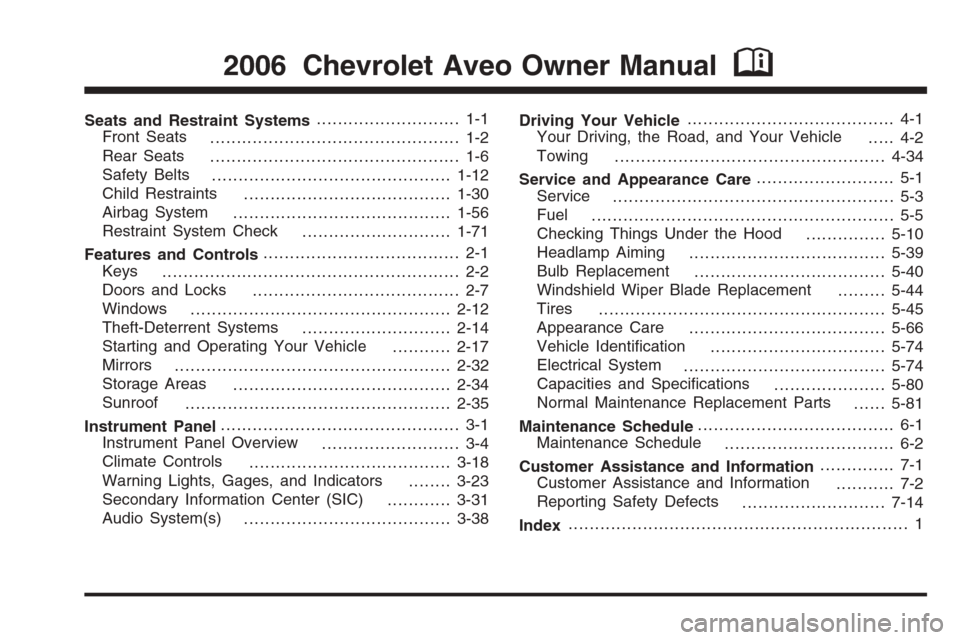
Seats and Restraint Systems........................... 1-1
Front Seats
............................................... 1-2
Rear Seats
............................................... 1-6
Safety Belts
.............................................1-12
Child Restraints
.......................................1-30
Airbag System
.........................................1-56
Restraint System Check
............................1-71
Features and Controls..................................... 2-1
Keys
........................................................ 2-2
Doors and Locks
....................................... 2-7
Windows
.................................................2-12
Theft-Deterrent Systems
............................2-14
Starting and Operating Your Vehicle
...........2-17
Mirrors
....................................................2-32
Storage Areas
.........................................2-34
Sunroof
..................................................2-35
Instrument Panel............................................. 3-1
Instrument Panel Overview
.......................... 3-4
Climate Controls
......................................3-18
Warning Lights, Gages, and Indicators
........3-23
Secondary Information Center (SIC)
............3-31
Audio System(s)
.......................................3-38Driving Your Vehicle....................................... 4-1
Your Driving, the Road, and Your Vehicle
..... 4-2
Towing
...................................................4-34
Service and Appearance Care.......................... 5-1
Service
..................................................... 5-3
Fuel
......................................................... 5-5
Checking Things Under the Hood
...............5-10
Headlamp Aiming
.....................................5-39
Bulb Replacement
....................................5-40
Windshield Wiper Blade Replacement
.........5-44
Tires
......................................................5-45
Appearance Care
.....................................5-66
Vehicle Identification
.................................5-74
Electrical System
......................................5-74
Capacities and Specifications
.....................5-80
Normal Maintenance Replacement Parts
......5-81
Maintenance Schedule..................................... 6-1
Maintenance Schedule
................................ 6-2
Customer Assistance and Information.............. 7-1
Customer Assistance and Information
........... 7-2
Reporting Safety Defects
...........................7-14
Index................................................................ 1
2006 Chevrolet Aveo Owner ManualM
Page 7 of 362
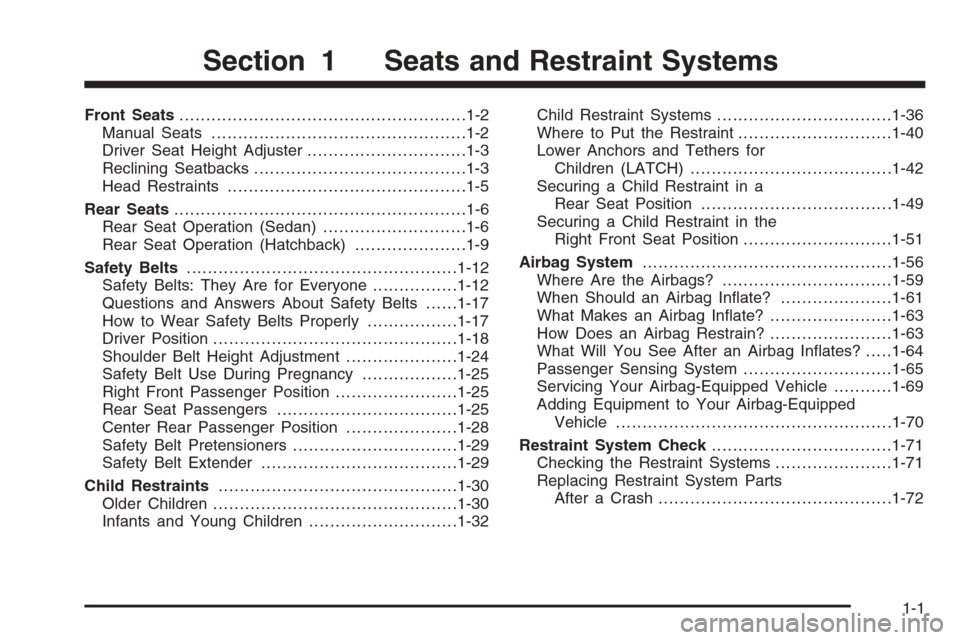
Front Seats......................................................1-2
Manual Seats................................................1-2
Driver Seat Height Adjuster..............................1-3
Reclining Seatbacks........................................1-3
Head Restraints.............................................1-5
Rear Seats.......................................................1-6
Rear Seat Operation (Sedan)...........................1-6
Rear Seat Operation (Hatchback).....................1-9
Safety Belts...................................................1-12
Safety Belts: They Are for Everyone................1-12
Questions and Answers About Safety Belts......1-17
How to Wear Safety Belts Properly.................1-17
Driver Position..............................................1-18
Shoulder Belt Height Adjustment.....................1-24
Safety Belt Use During Pregnancy..................1-25
Right Front Passenger Position.......................1-25
Rear Seat Passengers..................................1-25
Center Rear Passenger Position.....................1-28
Safety Belt Pretensioners...............................1-29
Safety Belt Extender.....................................1-29
Child Restraints.............................................1-30
Older Children..............................................1-30
Infants and Young Children............................1-32Child Restraint Systems.................................1-36
Where to Put the Restraint.............................1-40
Lower Anchors and Tethers for
Children (LATCH)......................................1-42
Securing a Child Restraint in a
Rear Seat Position....................................1-49
Securing a Child Restraint in the
Right Front Seat Position............................1-51
Airbag System...............................................1-56
Where Are the Airbags?................................1-59
When Should an Airbag Inflate?.....................1-61
What Makes an Airbag Inflate?.......................1-63
How Does an Airbag Restrain?.......................1-63
What Will You See After an Airbag Inflates?.....1-64
Passenger Sensing System............................1-65
Servicing Your Airbag-Equipped Vehicle...........1-69
Adding Equipment to Your Airbag-Equipped
Vehicle....................................................1-70
Restraint System Check..................................1-71
Checking the Restraint Systems......................1-71
Replacing Restraint System Parts
After a Crash............................................1-72
Section 1 Seats and Restraint Systems
1-1
Page 11 of 362
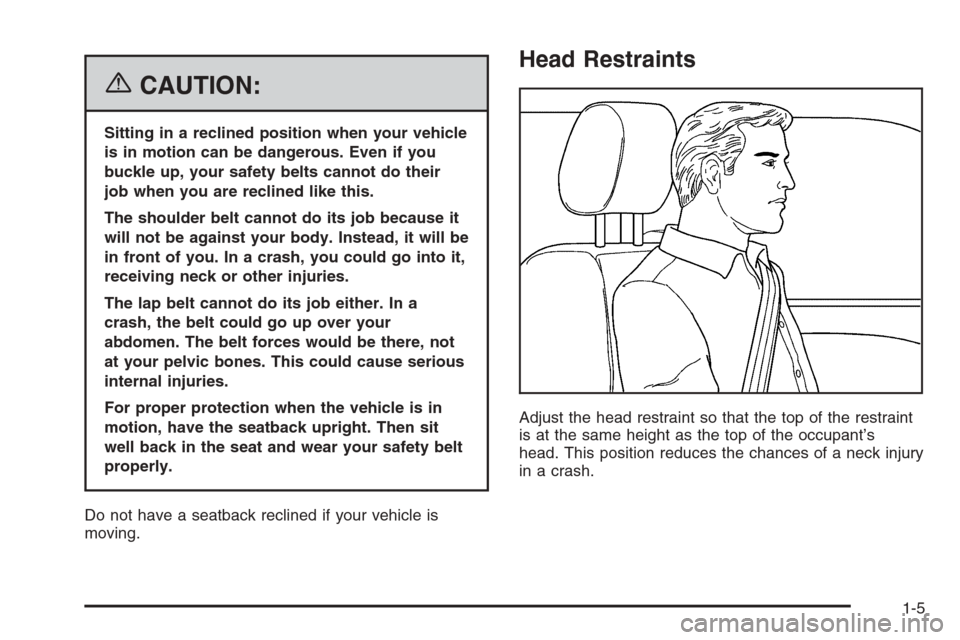
{CAUTION:
Sitting in a reclined position when your vehicle
is in motion can be dangerous. Even if you
buckle up, your safety belts cannot do their
job when you are reclined like this.
The shoulder belt cannot do its job because it
will not be against your body. Instead, it will be
in front of you. In a crash, you could go into it,
receiving neck or other injuries.
The lap belt cannot do its job either. In a
crash, the belt could go up over your
abdomen. The belt forces would be there, not
at your pelvic bones. This could cause serious
internal injuries.
For proper protection when the vehicle is in
motion, have the seatback upright. Then sit
well back in the seat and wear your safety belt
properly.
Do not have a seatback reclined if your vehicle is
moving.
Head Restraints
Adjust the head restraint so that the top of the restraint
is at the same height as the top of the occupant’s
head. This position reduces the chances of a neck injury
in a crash.
1-5
Page 12 of 362
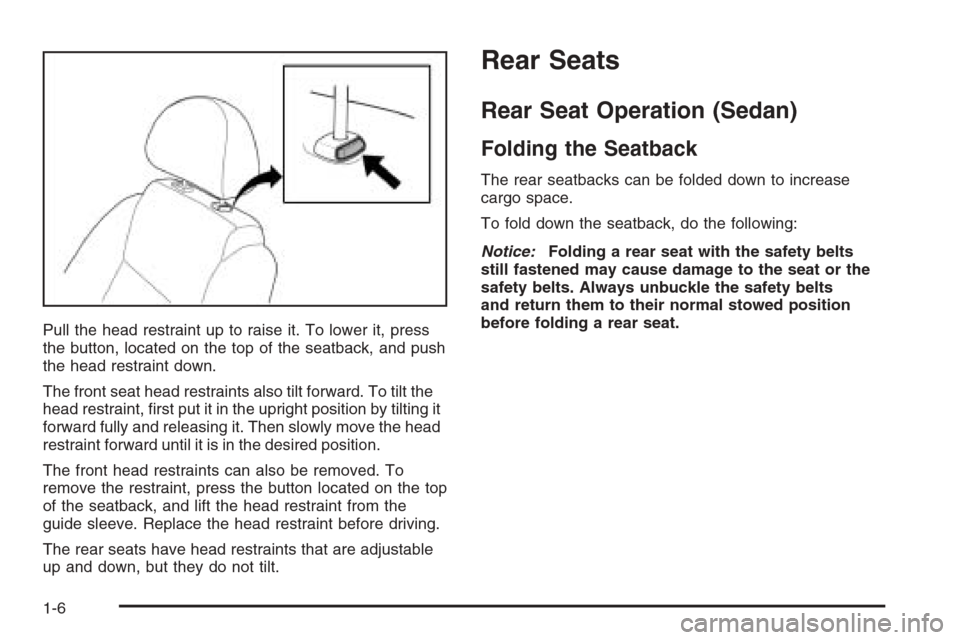
Pull the head restraint up to raise it. To lower it, press
the button, located on the top of the seatback, and push
the head restraint down.
The front seat head restraints also tilt forward. To tilt the
head restraint, first put it in the upright position by tilting it
forward fully and releasing it. Then slowly move the head
restraint forward until it is in the desired position.
The front head restraints can also be removed. To
remove the restraint, press the button located on the top
of the seatback, and lift the head restraint from the
guide sleeve. Replace the head restraint before driving.
The rear seats have head restraints that are adjustable
up and down, but they do not tilt.
Rear Seats
Rear Seat Operation (Sedan)
Folding the Seatback
The rear seatbacks can be folded down to increase
cargo space.
To fold down the seatback, do the following:
Notice:Folding a rear seat with the safety belts
still fastened may cause damage to the seat or the
safety belts. Always unbuckle the safety belts
and return them to their normal stowed position
before folding a rear seat.
1-6
Page 13 of 362
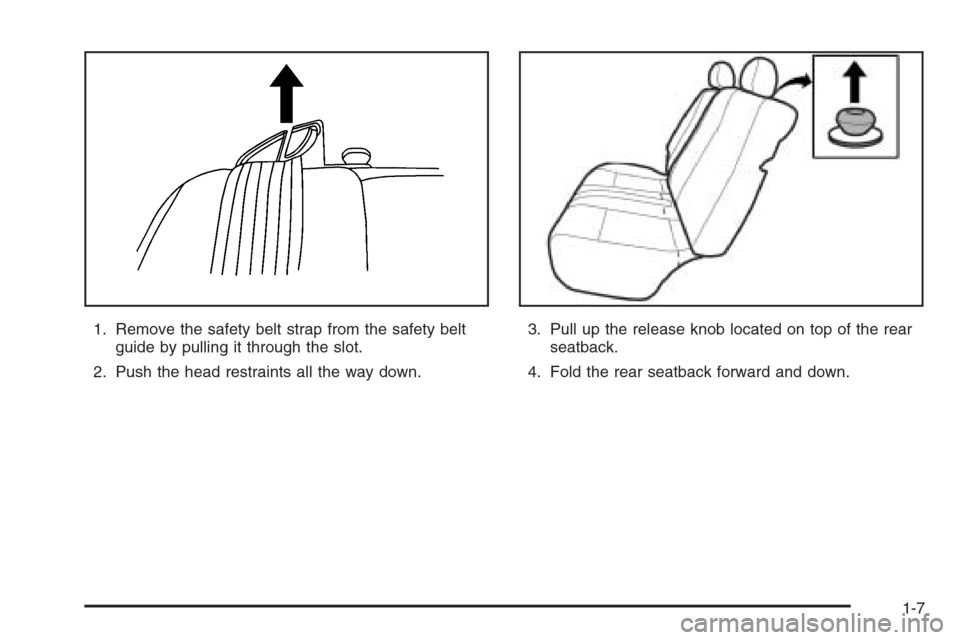
1. Remove the safety belt strap from the safety belt
guide by pulling it through the slot.
2. Push the head restraints all the way down.3. Pull up the release knob located on top of the rear
seatback.
4. Fold the rear seatback forward and down.
1-7
Page 14 of 362
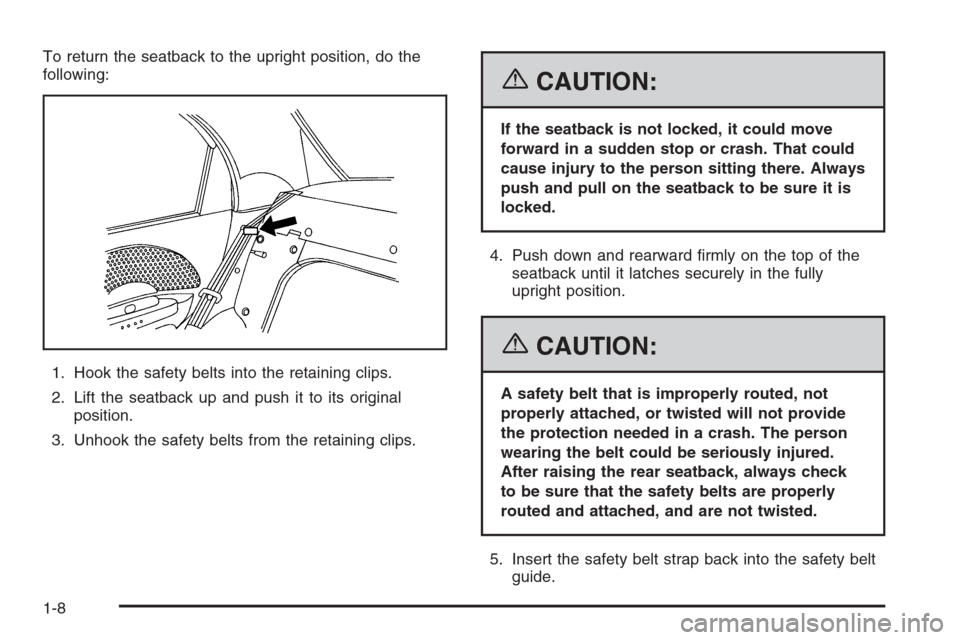
To return the seatback to the upright position, do the
following:
1. Hook the safety belts into the retaining clips.
2. Lift the seatback up and push it to its original
position.
3. Unhook the safety belts from the retaining clips.
{CAUTION:
If the seatback is not locked, it could move
forward in a sudden stop or crash. That could
cause injury to the person sitting there. Always
push and pull on the seatback to be sure it is
locked.
4. Push down and rearward firmly on the top of the
seatback until it latches securely in the fully
upright position.
{CAUTION:
A safety belt that is improperly routed, not
properly attached, or twisted will not provide
the protection needed in a crash. The person
wearing the belt could be seriously injured.
After raising the rear seatback, always check
to be sure that the safety belts are properly
routed and attached, and are not twisted.
5. Insert the safety belt strap back into the safety belt
guide.
1-8
Page 15 of 362
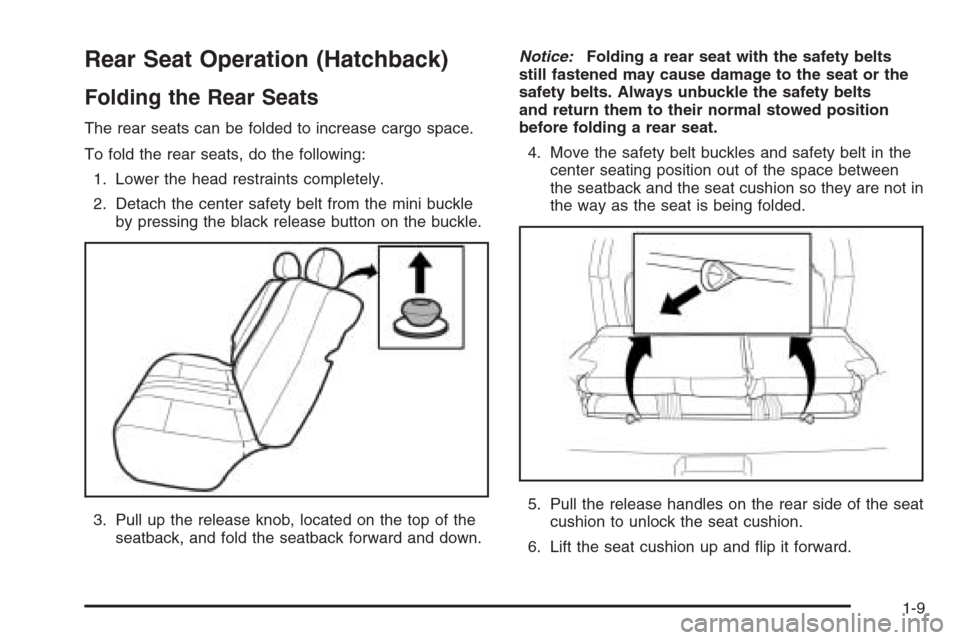
Rear Seat Operation (Hatchback)
Folding the Rear Seats
The rear seats can be folded to increase cargo space.
To fold the rear seats, do the following:
1. Lower the head restraints completely.
2. Detach the center safety belt from the mini buckle
by pressing the black release button on the buckle.
3. Pull up the release knob, located on the top of the
seatback, and fold the seatback forward and down.Notice:Folding a rear seat with the safety belts
still fastened may cause damage to the seat or the
safety belts. Always unbuckle the safety belts
and return them to their normal stowed position
before folding a rear seat.
4. Move the safety belt buckles and safety belt in the
center seating position out of the space between
the seatback and the seat cushion so they are not in
the way as the seat is being folded.
5. Pull the release handles on the rear side of the seat
cushion to unlock the seat cushion.
6. Lift the seat cushion up and flip it forward.
1-9
Page 16 of 362
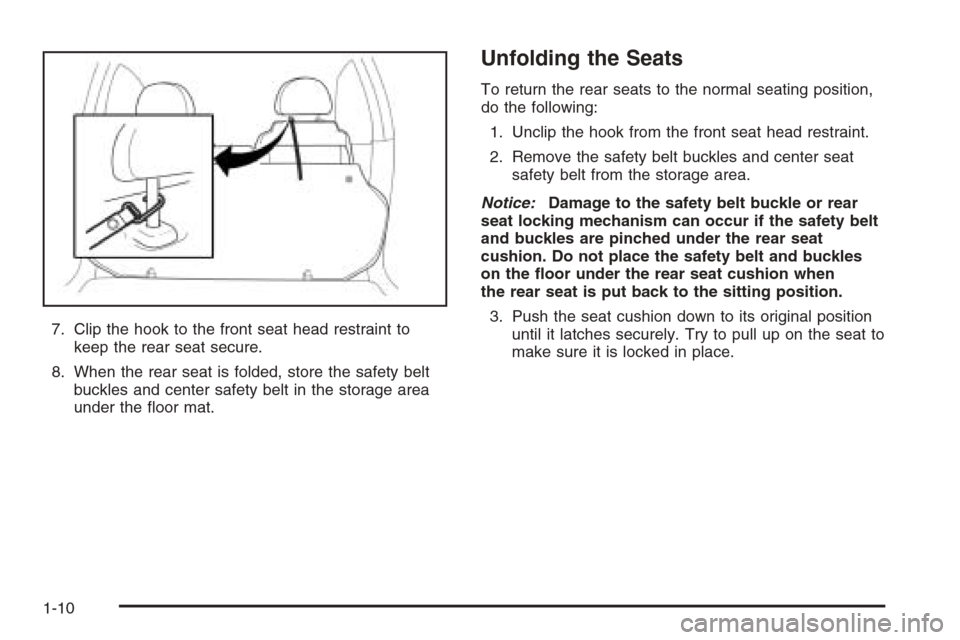
7. Clip the hook to the front seat head restraint to
keep the rear seat secure.
8. When the rear seat is folded, store the safety belt
buckles and center safety belt in the storage area
under the floor mat.
Unfolding the Seats
To return the rear seats to the normal seating position,
do the following:
1. Unclip the hook from the front seat head restraint.
2. Remove the safety belt buckles and center seat
safety belt from the storage area.
Notice:Damage to the safety belt buckle or rear
seat locking mechanism can occur if the safety belt
and buckles are pinched under the rear seat
cushion. Do not place the safety belt and buckles
on the �oor under the rear seat cushion when
the rear seat is put back to the sitting position.
3. Push the seat cushion down to its original position
until it latches securely. Try to pull up on the seat to
make sure it is locked in place.
1-10
Page 17 of 362
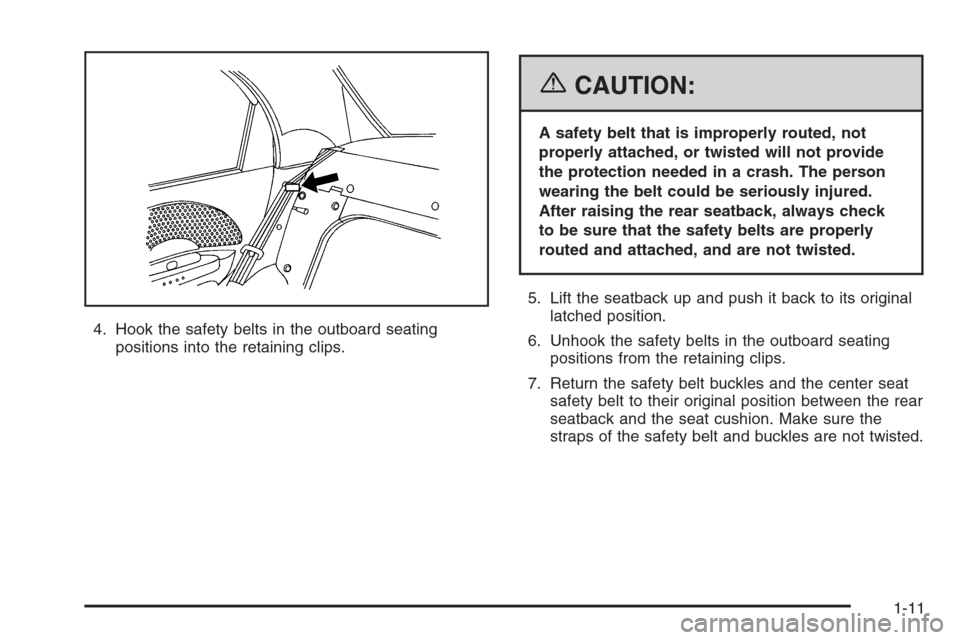
4. Hook the safety belts in the outboard seating
positions into the retaining clips.
{CAUTION:
A safety belt that is improperly routed, not
properly attached, or twisted will not provide
the protection needed in a crash. The person
wearing the belt could be seriously injured.
After raising the rear seatback, always check
to be sure that the safety belts are properly
routed and attached, and are not twisted.
5. Lift the seatback up and push it back to its original
latched position.
6. Unhook the safety belts in the outboard seating
positions from the retaining clips.
7. Return the safety belt buckles and the center seat
safety belt to their original position between the rear
seatback and the seat cushion. Make sure the
straps of the safety belt and buckles are not twisted.
1-11
Page 18 of 362
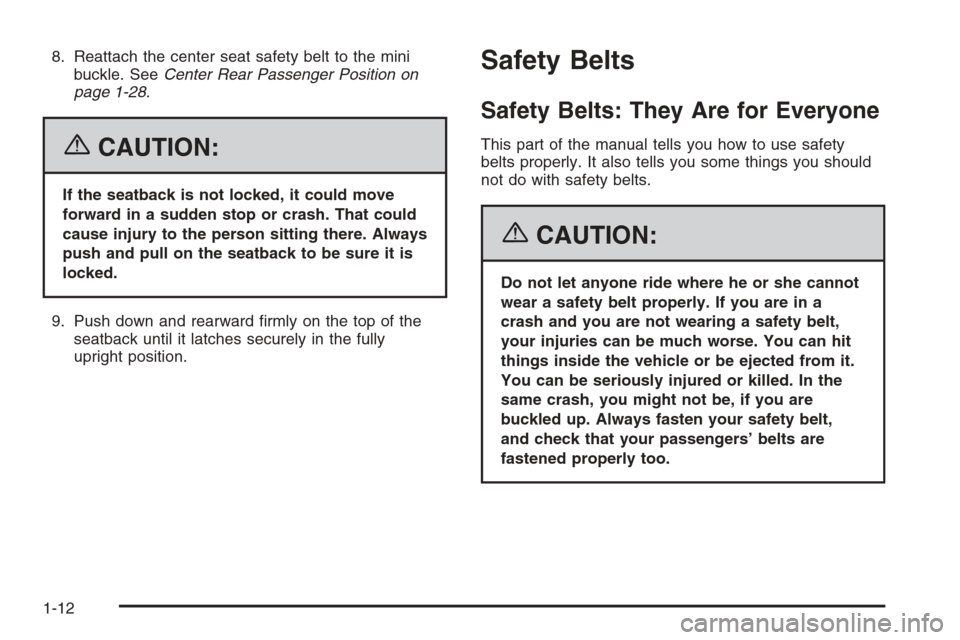
8. Reattach the center seat safety belt to the mini
buckle. SeeCenter Rear Passenger Position on
page 1-28.
{CAUTION:
If the seatback is not locked, it could move
forward in a sudden stop or crash. That could
cause injury to the person sitting there. Always
push and pull on the seatback to be sure it is
locked.
9. Push down and rearward firmly on the top of the
seatback until it latches securely in the fully
upright position.
Safety Belts
Safety Belts: They Are for Everyone
This part of the manual tells you how to use safety
belts properly. It also tells you some things you should
not do with safety belts.
{CAUTION:
Do not let anyone ride where he or she cannot
wear a safety belt properly. If you are in a
crash and you are not wearing a safety belt,
your injuries can be much worse. You can hit
things inside the vehicle or be ejected from it.
You can be seriously injured or killed. In the
same crash, you might not be, if you are
buckled up. Always fasten your safety belt,
and check that your passengers’ belts are
fastened properly too.
1-12